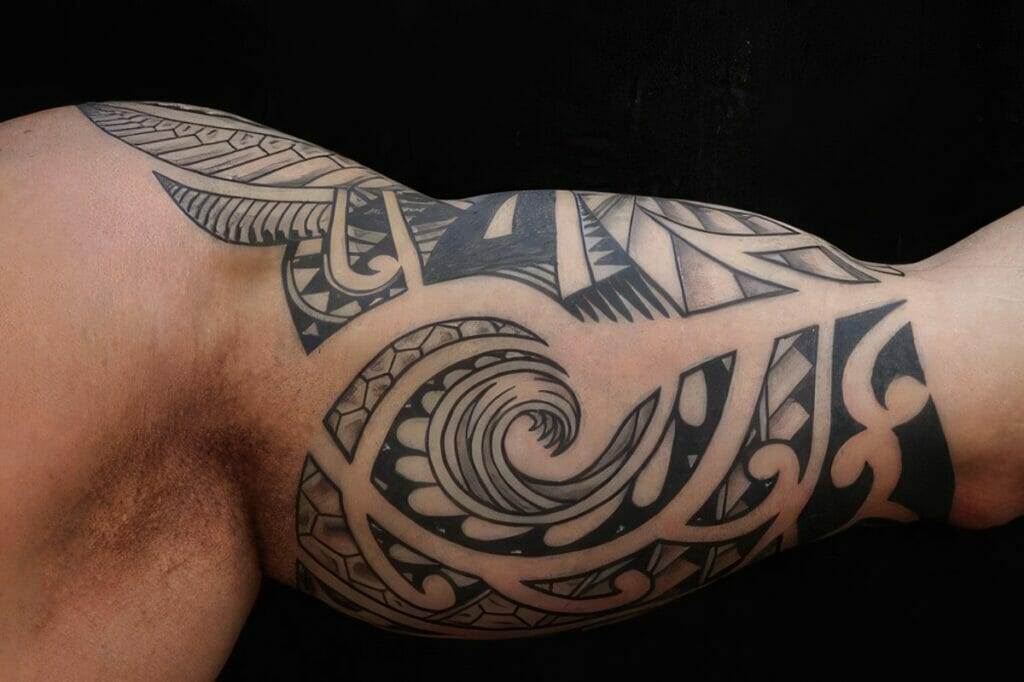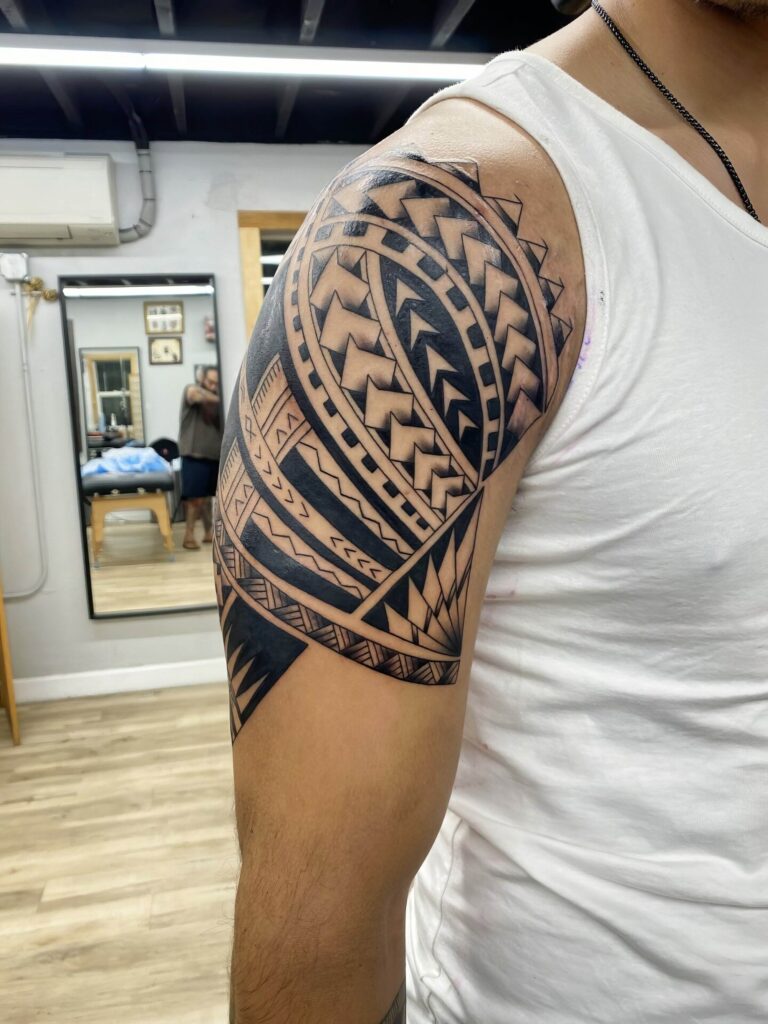
Tattoos have a rich history that dates back thousands of years. From ancient civilizations to modern culture, tattoos have been used as a form of self-expression, a way to commemorate important events or people, and a symbol of identity or belonging. In recent years, tattoos have become increasingly popular and accepted in mainstream society. This article will explore the significance of tattoos in today’s culture, provide tips for choosing the right design, finding a reputable tattoo artist, and navigating the tattooing process.

Understanding the significance of tattoos in today’s culture
A. Tattoos as a form of self-expression
Tattoos have long been used as a means of self-expression. They allow individuals to showcase their unique personalities, beliefs, and interests through art on their bodies. Whether it’s a small symbol or a full sleeve, tattoos can be a powerful way to communicate who you are to the world. They can serve as a visual representation of your values, passions, and experiences.
B. Tattoos as a way to commemorate important events or people
Many people choose to get tattoos to commemorate significant events or people in their lives. This could be anything from the birth of a child to the loss of a loved one. Tattoos can serve as a permanent reminder of these important moments and can provide comfort and healing during difficult times. They can also be a way to honor and remember someone who has passed away.
C. Tattoos as a symbol of identity or belonging
Tattoos can also be used as a symbol of identity or belonging. They can represent membership in a particular group or community, such as military service or a specific cultural heritage. Tattoos can also be used to express solidarity with a social or political cause. For many individuals, tattoos are a way to feel connected to something larger than themselves and to express their sense of identity and belonging.
Choosing the right design that reflects your personality and values
A. Researching different styles and designs
When choosing a tattoo design, it’s important to do your research and explore different styles and designs. Look at tattoo magazines, websites, and social media platforms to get inspiration and ideas. Consider the style of tattoo that resonates with you, whether it’s traditional, realistic, geometric, or something else entirely. Think about the imagery and symbols that hold personal meaning for you and how they can be incorporated into a design.
B. Considering the placement of the tattoo
The placement of your tattoo is just as important as the design itself. Think about where you want your tattoo to be visible or if you prefer it to be more discreet. Consider how the placement may affect your ability to cover up the tattoo if necessary for professional or social reasons. Keep in mind that certain areas of the body may be more painful to tattoo than others, so take that into consideration when choosing the placement.
C. Choosing a design that holds personal meaning
Ultimately, the most important aspect of choosing a tattoo design is finding something that holds personal meaning for you. It could be a symbol that represents a core value or belief, a quote that inspires you, or an image that reminds you of an important person or event in your life. Take the time to reflect on what is truly meaningful to you and choose a design that reflects that.
Preparing mentally and physically for the tattooing process
A. Getting enough rest and hydration
In the days leading up to your tattoo appointment, make sure you are getting enough rest and staying hydrated. This will help ensure that your body is in the best possible condition for the tattooing process. Proper rest and hydration can also help reduce any potential discomfort during the tattoo.
B. Eating a healthy meal before the appointment
It’s important to eat a healthy meal before your tattoo appointment to keep your energy levels up and prevent lightheadedness or dizziness during the process. Avoid consuming alcohol or caffeine before your appointment, as they can thin your blood and make the tattooing process more difficult.
C. Practicing relaxation techniques to reduce anxiety
If you are feeling anxious or nervous about getting a tattoo, practicing relaxation techniques can be helpful. Deep breathing exercises, meditation, or listening to calming music can help calm your mind and reduce anxiety. Remember that it’s normal to feel some nervousness before getting a tattoo, but focusing on relaxation techniques can help make the experience more enjoyable.
Dealing with the fear and anxiety of getting a tattoo
A. Communicating with the artist about any concerns
If you have any concerns or fears about getting a tattoo, it’s important to communicate them with your tattoo artist. They are experienced professionals who have likely dealt with nervous clients before and can offer reassurance and guidance. They can also adjust their approach to accommodate your needs and make the experience as comfortable as possible.
B. Bringing a friend or family member for support
If you are feeling particularly anxious about getting a tattoo, consider bringing a friend or family member with you for support. Having someone familiar by your side can provide comfort and help distract you from any discomfort or anxiety. Just make sure that the person you bring is supportive and understanding of your decision to get a tattoo.
C. Focusing on the end result and the personal meaning behind the tattoo
When fear or anxiety starts to creep in, try to focus on the end result and the personal meaning behind the tattoo. Remind yourself of why you chose to get the tattoo in the first place and how it will serve as a form of self-expression or commemoration. Keeping the bigger picture in mind can help alleviate any temporary discomfort or anxiety.
Navigating the pain and discomfort during the tattooing process
A. Using numbing creams or pain relievers if necessary
If you are concerned about the pain associated with getting a tattoo, there are options available to help manage discomfort. Numbing creams can be applied to the skin before the tattooing process to help dull any pain. Additionally, over-the-counter pain relievers such as ibuprofen can be taken prior to your appointment to help reduce any discomfort.
B. Taking breaks if needed
During the tattooing process, it’s important to listen to your body and take breaks if needed. Tattoo sessions can be lengthy, especially for larger or more complex designs, so it’s important to communicate with your artist if you need a break to stretch, use the restroom, or simply take a breather. Taking breaks can help alleviate any physical discomfort and make the process more manageable.
C. Practicing deep breathing and relaxation techniques
Throughout the tattooing process, practicing deep breathing and relaxation techniques can help manage any discomfort or anxiety. Focus on taking slow, deep breaths and try to relax your body as much as possible. Some people find it helpful to listen to calming music or engage in visualization exercises to distract from any discomfort.
Understanding the aftercare process to ensure proper healing
A. Following the artist’s instructions for cleaning and care
After getting a tattoo, it’s important to follow the artist’s instructions for cleaning and care to ensure proper healing. This typically involves washing the tattoo with a mild soap, applying a thin layer of ointment or moisturizer, and keeping the tattoo clean and dry. Avoid picking or scratching at the tattoo, as this can lead to infection or damage to the design.
B. Avoiding certain activities or environments during the healing process
During the healing process, it’s important to avoid certain activities or environments that can interfere with proper healing. This includes avoiding swimming pools, hot tubs, saunas, and excessive sun exposure. It’s also important to avoid wearing tight clothing or anything that may rub against the tattoo and cause irritation.
C. Monitoring the tattoo for signs of infection or complications
While most tattoos heal without any issues, it’s important to monitor your tattoo for signs of infection or complications. This includes redness, swelling, excessive pain, pus, or a foul odor coming from the tattoo. If you notice any of these symptoms, it’s important to seek medical attention as soon as possible.

Avoiding common mistakes and complications during the healing process
A. Not picking or scratching at the tattoo
One of the most common mistakes people make during the healing process is picking or scratching at their tattoo. This can lead to scarring, infection, and damage to the design. It’s important to resist the urge to scratch or pick at any scabs or flakes that may form as the tattoo heals.
B. Avoiding exposure to sunlight or water during the healing process
Exposure to sunlight and water can be detrimental to a healing tattoo. Sunlight can cause the tattoo to fade prematurely, while water can introduce bacteria and increase the risk of infection. It’s important to keep your tattoo covered and protected from the sun and avoid submerging it in water until it is fully healed.
C. Seeking medical attention if any issues arise
If you experience any issues or complications during the healing process, it’s important to seek medical attention. This includes signs of infection, excessive pain, or any other concerns that arise. A healthcare professional can provide guidance and treatment to ensure proper healing.
Incorporating tattoo care into your daily routine for long-term maintenance
A. Using sunscreen to protect the tattoo from fading
To maintain the vibrancy of your tattoo over time, it’s important to protect it from sun exposure. Apply a broad-spectrum sunscreen with a high SPF to your tattoo whenever it will be exposed to the sun. This will help prevent fading and keep your tattoo looking its best.
B. Moisturizing the tattoo regularly
Keeping your tattoo moisturized is essential for long-term maintenance. Apply a fragrance-free, gentle moisturizer to your tattoo regularly to keep the skin hydrated and prevent dryness or flaking. Avoid using products with harsh chemicals or fragrances, as they can irritate the skin.
C. Touching up the tattoo as needed
Over time, tattoos may fade or lose some of their vibrancy. If you notice that your tattoo is starting to look dull or faded, consider scheduling a touch-up session with your tattoo artist. They can rework the design and add fresh ink to restore its original appearance.
Addressing any potential social or professional implications of having a tattoo
A. Understanding company policies and dress codes
If you have concerns about how your tattoo may be perceived in a professional setting, it’s important to understand your company’s policies and dress codes. Some companies may have strict guidelines regarding visible tattoos, while others may be more lenient. Familiarize yourself with these policies and dress accordingly to avoid any potential issues.
B. Being prepared to cover up the tattoo if necessary
In situations where it may be necessary to cover up your tattoo, it’s important to be prepared. Invest in clothing or accessories that can help conceal your tattoo when needed. This could include long-sleeved shirts, scarves, or makeup specifically designed to cover tattoos.
C. Educating others about the personal meaning behind the tattoo
If you encounter judgment or negative comments about your tattoo, remember that it is ultimately a personal choice and expression of self. Take the opportunity to educate others about the personal meaning behind your tattoo and why it is important to you. This can help foster understanding and acceptance.

Embracing your new tattoo and the personal meaning it holds for you
A. Showing off the tattoo with pride
Once your tattoo is healed, embrace it and show it off with pride. Wear clothing that allows your tattoo to be visible if you choose, and don’t be afraid to share the story behind your tattoo with others who show interest. Your tattoo is a reflection of who you are, so embrace it as a part of your identity.
B. Reflecting on the personal significance of the tattoo
Take time to reflect on the personal significance of your tattoo and what it means to you. Consider how it has impacted your life and how it serves as a reminder of important events or people. Reflecting on the personal significance can deepen your connection to your tattoo and enhance its meaning.
C. Planning future tattoos to continue the self-expression journey
For many people, getting a tattoo is just the beginning of their self-expression journey. As you continue to grow and evolve, you may find that you want to add more tattoos to your collection. Take the time to plan future tattoos that reflect your changing interests, beliefs, and experiences. Each tattoo can be a unique piece of your personal story.
Tattoos have become an increasingly popular form of self-expression in modern culture. They hold personal meaning and can serve as a way to commemorate important events or people. Choosing the right design, finding a reputable tattoo artist, and navigating the tattooing process are all important steps in ensuring a positive experience. By understanding the significance of tattoos, preparing mentally and physically, and properly caring for your tattoo during the healing process, you can embrace your new ink with pride and continue your self-expression journey.






